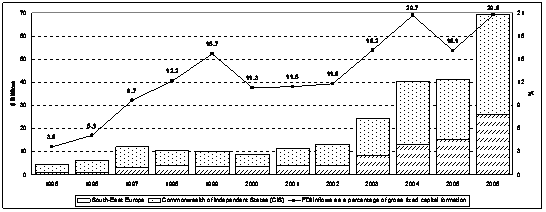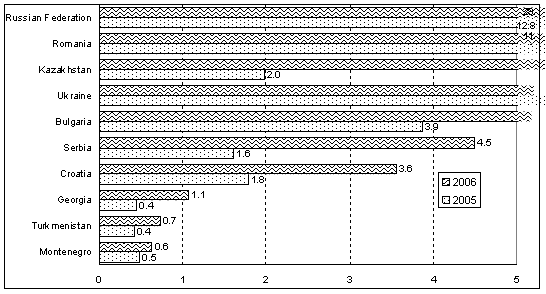| EMBARGO The contents of this press release and the related Report must not be quoted or summarized in the print, broadcast or electronic media before 16 October 2007, 17:00 GMT (1PM New York, 19:00 Geneva, 22:30 New Delhi, 02:00 17 October Tokyo) |
Flows of foreign direct investment (FDI) to South-East Europe and the Commonwealth of Independent States (CIS) jumped by 68% in 2006 to US$69 billion, marking the sixth consecutive year of growth and recording a significant leap over the two previous years (figure 1), reveals UNCTAD´s World Investment Report 2007: Transnational Corporations, Extractive Industries and Development (1).
FDI inflows were concentrated in five nations: the Russian Federation, Romania, Kazakhstan, the Ukraine, and Bulgaria, in that order (figure 2). Together, they accounted for 82% of total incoming FDI to the region. Inflows to the largest economy, the Russian Federation, more than doubled to a record $29 billion, despite an apparent tightening of national legislation on extraction contracts and on foreigners´ access to natural resources. Flows to Romania and Bulgaria grew significantly in 2006 because they were to join the European Union on 1 January 2007. Romania was the second-largest FDI recipient in the region, with most of its inflows linked to privatization. While oil and gas projects led FDI inflows to an unprecedented level in Kazakhstan (more than $6 billion), a reduction of privatization-related FDI combined with the abolition of incentives in special economic zones, may have contributed to decreased inflows to the Ukraine.
Developed countries remained the main investors in the region, although the share of developing-country TNCs in cross-border merger and acquisitions (M&As), led by Chinese firms, rose to 16% in 2006 from a mere 1% in 2005.
FDI outflows from South-East Europe and the CIS in 2006 increased to $19 billion from $15 billion in 2005. Almost all of this outward FDI (96%) reflected the expansion of Russian TNCs abroad, especially large resource-based firms seeking to become global players and banks expanding into other CIS countries. Half the investor-funded greenfield projects in South-East Europe and the CIS were undertaken by TNCs based in the region and were concentrated mainly in extraction activities such as mining and oil drilling. The services sector was particularly buoyant due to increased cross-border mergers and acquisitions (M&As) in the banking industry. And the primary sector received higher inflows as a result of soaring demand for natural resources.
In some natural-resource-based economies of the CIS, such as the Russian Federation, Kazakhstan, and Uzbekistan, states have continued to increase their control of strategic industries, either through preventing or limiting the direct control of resources by foreign investors, or by adopting indirect measures, such as stricter environmental standards, which put pressure on foreign companies. By contrast, the business climate for foreign investors has improved in non-strategic industries. In the context of their bids for World Trade Organization (WTO) membership, some CIS countries, such as Ukraine and the Russian Federation, harmonized their legislation with WTO norms and standards. In South-East European countries, policies have been drawn into line with accession to the European Union as well as with national plans to accelerate the privatization of state assets, especially in the telecom and energy industries.
The report predicts that FDI in South-East Europe and the CIS will be particularly buoyant in the larger economies, such as the Russian Federation and Ukraine, and in the newest EU members, Bulgaria and Romania. This surge is expected to be driven by increasing interest among foreign firms in access to these countries´ natural resources, even under stricter conditions, and by the robust economic growth of these countries.
The World Investment Report and its database are available online at http://www.unctad.org/wir and http://www.unctad.org/fdistatistics |
ANNEX
Tables and figures
Figure 1. South-East Europe and CIS: FDI inflows and their share in gross fixed capital formation, 1995-2006
Source: UNCTAD, World Investment Report 2007
Figure 2. South-East Europe and CIS: FDI inflows, top 10 economies, 2005-2006a(Billions of dollars)
Source: UNCTAD, World Investment Report 2007
Note: a Ranked on the basis of the magnitude of the 2006 FDI inflows.


